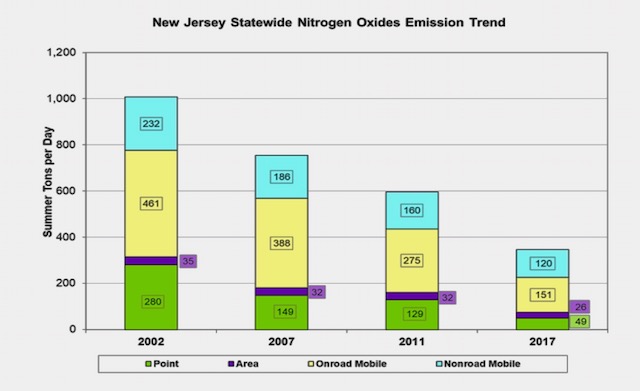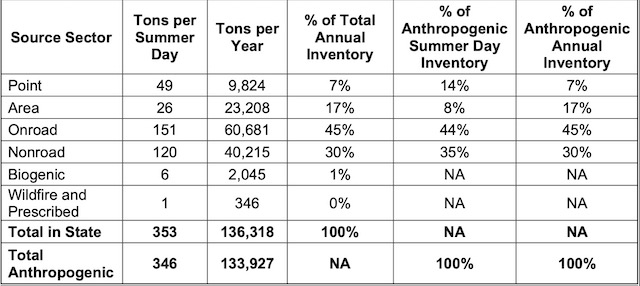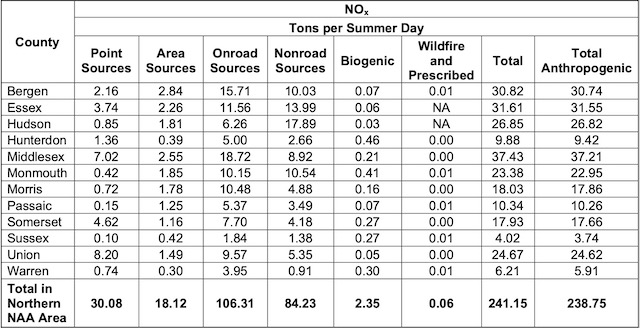Proposal Discusses Public Health And Environmental Justice Impacts
But No Limits On Greenhouse Gas Emissions Or EJ Protections
Multiple Loopholes – Tiny Emissions Reductions, Just 0.03% Of Total Emissions
[Update below]
Today, the Murphy DEP proposed new rules to limit air pollution from Mobile Cargo Handling Equipment at Ports and Intermodal Rail Yards (read the DEP proposal here).
Before I summarize the substance of the proposal, I must grudgingly give DEP credit for 3 things for which I have severely criticized them in the recent past: (could it be that they are listening to that criticism?)
1) DEP will hold a public hearing (contrary to prior recent air SIP amendments)
2) DEP discussed interrelated environmental justice and climate impacts (contrary to the proposed CO2 emissions rule)
3) DEP discussed interrelated public health and climate impacts (contrary to diesel and CO2 proposals)
But, despite those positives, the proposal is NOT based on the adverse public health and environmental justice impacts discussed. The proposal reflects a technology based approach (BACT), based on performance standards.
Just as bad, the proposals fails to consider or regulate greenhouse gas emissions. It is designed to address only particulate matter (PM) and oxides of nitrogen (NOx).
The DEP estimated (ideal – best case) emissions reductions of those pollutants are very small (and you have to read to page 61 to find that out):
The Department estimates potential emission reductions from cargo handling equipment at PANY/NJ terminals to be 82 tons of NOx and 6.4 tons of PM2.5 in 2028 and cumulative emissions reductions of 500 tons of NOX, and 38 tons of PM2.5 from 2024 through 2035.
Just how small?
The DEP provides no context for these emissions reductions, e.g as a percentage of total emissions, or as a percentage of this source’s current emissions, that would allow the public to gauge the significance of the proposal and its impacts.
There’s a reason DEP does not do that – because the emissions reductions are so small as to be laughable.
For context, to illustrate just how small, I had to go to the DEP’s most recent air pollution emissions inventory.
It looks like “non-road mobile sources” are 13% of total statewide annual PM emissions and 35% of annual NOx emissions, but this rule applies to a small subset of those sources.
Total annual NOx emissions are (346 tpd) X (365 days) = 126,290 tons/year (on the high side, because I used DEP’s summer daily emissions rate)
As such, DEP’s estimated 500 ton NOx cumulative reduction, over an 11 year period, amounts to just 45.5 tons/year.
That is a tiny fraction of 126,290 tons/year emitted, just 0.03% of total annual NOx emissions!
Wow. That’s even less than DEP’s proposed CO2 rule, which would reduce annual GHG emission by just 2.6%! (but way out in year 2035).
The particulate emissions reductions as a percentage of total annual emissions are even smaller – by orders of magnitude – so I won’t even waste time to calculate them. Go to DEP emissions inventory and do that wasted effort yourself.
Just shutting down the Newark incinerator would reduce NOx emissions by 138 tons/year this year (2022), more than 3 TIMES the NOx reductions that ideally could result from this rule in over a decade.
Shutting down Newark incinerator would have far greater particulate reductions (TSP, PM 10, PM 2.5).
Shutting down all 4 garbage incinerators would provide even more benefits and directly to environmental justice communities NOW, not 10 years from now.
Summary of the Proposal
At the outset, we need to make one important issue clear.
Despite a lot of misleading spin in the summary of the proposal, this is not a discretionary rule that was initiated by the Murphy DEP as part of their Climate PACT initiative or the Governor’s Executive Orders on climate or the Global Warming Response Act.
The DEP was required to propose this rule by the federal Clean Air Act due to violations of national standards. DEP admits this, in a very indirectly way:
This rulemaking concerns diesel-fueled mobile sources at ports and intermodal rail yards. Specifically, the Department proposes rules based on California’s regulation requiring diesel mobile cargo handling equipment at ports and intermodal rail yards to apply best available control technology while zero-emission technology continues to advance for this equipment. With the proposed rules, the Department expects to reduce diesel engine emissions, including NOx, particulate matter (PM), and PM2.5. New Jersey is in nonattainment for the Federal ozone national ambient air quality standard (NAAQS) and must continue to reduce NOx emissions Statewide to attain, and maintain, the ozone NAAQS.
So, keep the fact in mind that DEP had a federal gun to their head in proposing this rule.
Second, the rule is based on long-standing federal EPA standards, as modified by 7- 12 year old California standards (which in turn are based on EPA standards).
The takeaway is that NJ DEP did not rely on NJ’s more stringent Air Pollution Control Act to set more aggressive standards.
Third, the proposal is riddled with loopholes (P. 18):
The proposed rules allow for compliance extensions if there is a manufacturer delay in delivery of compliant equipment, for equipment that is operated less than 200 hours annually (low-use equipment), or if the existing equipment will be replaced with zero-emission equipment. If compliant equipment is not available for a particular use or application, the rules allow a case-by-case application of best available control technology for the particular equipment. The rules also allow fleet averaging as an alternate compliance option.
The DEP also provided “flexibility” and a compliance option for “fleet averaging”.
Fourth, the rule applies only to ports and cargo handling equipment, not all off road equipment and vehicles. This is a very small universe of pollution sources: (P. 23)
There are several locations in New Jersey that qualify as a “port” under the proposed rules, including, but not limited to, the Port of New York and New Jersey and ports along the Delaware River, such as Camden, Gloucester, Paulsboro, and Salem.
Fifth, the rule applies to certain rail yards, but still provides exemptions:
Two major railroad companies, CSX Transportation and Norfolk- Southern, operate several intermodal rail yards located in Newark, Elizabeth, Jersey City, North Bergen, and South Kearny, which are all cities in northern New Jersey. Thus, as proposed, the new subchapter will be applicable to all cargo handling equipment that operates within the boundaries of the intermodal railyard, unless the equipment is exempt pursuant to N.J.A.C. 7:27-34.2.
Sixth, the military got an exemption:
This subchapter also does not apply to “military tactical support cargo handling equipment”
Seventh, DEP did not provide data on the scope of this exemption, so I don’t know where it applies. Could this be the Delaware Frontier Energy LNG plant loophole?:(P. 26)
Another proposed limited exemption is for low-throughput ports that are further than 75 miles from an urban area, – with a two-year average annual cargo throughput of less than one million tons per year, excluding petroleum products
Eighth, the performance standards are based on 12 year old California standards, so I assume that manufacturers already meet the standards. Even for these dated performance standards, DEP provided a huge loophole:(P. 36)
Proposed N.J.A.C. 7:27-34.10, Alternate compliance options, sets forth general requirements for an owner or operator to request, and receive approval of, an alternate compliance option, if it is unable to comply with the performance standards proposed for new and in-use cargo handling equipment.
Ninth, despite finding that the California standards are old:
Tier 4 final has been required for all new off-road engines since 2015 and the Department is proposing to adopt the standards in the CHE Regulation many years after the CHE Regulation was first adopted.
the DEP still provided an extended 5 year phase in period:
Therefore, as provided at N.J.A.C. 7:27-34.6, Table 1, the Department proposes a five-year phased compliance schedule, with the older, more polluting cargo handling equipment required to comply earliest.
Tenth, as an “incentive”, DEP proposing another compliance delay break:(p.51
The Department proposes to allow up to a two-year compliance extension for an owner or operator who wishes to replace in-use cargo handling equipment with zero-emission equipment.
Eleventh, DEP provided enforcement grace periods:(p. 56). The DEP is not required, under the NJ Grace Prior Law, to allow grace periods. That is a discretionary act, i.e. DEP didn’t have to do it. And EPA may reject this as a violation of minimum federal requirements:
Under the Grace Period Law, N.J.S.A. 13:1D-125 to 133, a person responsible for a minor violation is afforded a period of time by the Department to correct the violation in order to avoid being subject to a penalty.
Finally, the overall pollution emissions reductions are very small:(p. 61)
The Department estimates potential emission reductions from cargo handling equipment at PANY/NJ terminals to be 82 tons of NOx and 6.4 tons of PM2.5 in 2028 and cumulative emissions reductions of 500 tons of NOX, and 38 tons of PM2.5 from 2024 through 2035.
Conclusion: much to do about very little. But expected the media to exaggerate the impacts.
[Update: 1/4/22 – As predicted, NJ Spotlight exaggerates and provides no context for the DEP estimated emissions reduction impacts and makes significant fact errors. Let’s correct the 3 worst (emphasis mine):
In an effort to improve air quality around New Jersey’s ports, the state yesterday proposed tough new rules to crack down on pollution from cargo-handling equipment spewing diesel emissions in nearby communities.
1) from a regulatory perspective, the proposal is not “tough”. There are numerous loopholes, exemptions, compliance alternatives, case-by-case exceptions, compliance delays, and enforcement grace periods. Including these provisions in a rule makes it weak, not “tough” or strong. Additionally, the long timeframes and small emissions reductions make the rule weak as well.
The new rules, detailed in a 116-page proposal, are designed to comply with an executive order issued last year by Gov. Phil Murphy to reform and modernize air and land-use regulations to mitigate the effects of climate change in the state.
2) This is egregiously factually false and misleading. The rules are NOT designed to comply with Murphy’s EO and have nothing to do with climate change. The rules are required by the Clean Air Act as a result of NJ’s failure to meet federal EPA ground level ozone standards. They do not address any greenhouse gas emissions or climate goals and legally are not proposed pursuant to the NJ Global Warming Response Act.
Tom Johnson knows this, so he is lying to readers.
According to the DEP, the rule is estimated to reduce NOx emissions by 500 tons and particulate matter by 38 tons from 2024 to 2035. The state is proposing a change to its plan to meet the ozone health standard by reducing its NOx emissions.
3) This transcription of DEP’s proposal language fails to put the DEP estimated emissions reductions in context out suggest alternative ways of reducing emissions. Such context would show they are very small (0.03% of total) and there are much better alternative, like shutting down garbage incinerators.
Now let’s move to the substance.
Recall that I previously wrote about NJ DEP’s Clean Air Act SIP amendments to address ground level ozone. I was appalled by the lack of any public involvement with that important SIP revision, but was unable to open the documents at the time to review it.
This DEP propose rule is a part of the final SIP DEP previously submitted to EPA for approval.
So, just now, I was able to go back and open the DEP SIP documents.
First off, compounding the complexity of the regulatory framework, the way DEP writes and presents data makes it literally impossible to cross walk the SIP documents with the rule proposal to figure out what is going on.
Here’s the emissions inventory data for the bar chart above and broken down by county:
In searching the Final SIP for port cargo equipment, I came across these programs, which are directly related to the DEP’s proposed regulation. I am no longer certain that these programs are mandatory under the federal Clean Air Act. It also is unclear how much program overlap there is and if there is possible double counting going on – but the estimated emissions reductions are conflicting.
One thing is clear however: the Murphy administration is providing enormous public subsidies to very profitable corporations that run one of the largest and most profitable ports in the world.
Here’s the DEP SIP programs on port cargo equipment:
Other Transportation and Clean Air Initiatives (p. xvi)
- $36 million to reduce diesel and black carbon emissions in environmental justice communities by electrifying port, cargo handling, and other medium- and heavy-duty equipment in port and industrial areas.
Port Authority of New York and New Jersey Cargo Handling Equipment (p. 3-21)
A Fleet Modernization and Replacement Program for Cargo Handling Equipment is intended to replace yard equipment that serve the Port Authority’s marine terminals located in Essex and Union counties with new cleaner burning equipment. This project is sponsored by the Port Authority of New York and New Jersey and was funded by a $2 million federal Congestion Mitigation Air Quality (CMAQ) grant. It incentivizes port tenants to replace their older fleet with new equipment with Tier IV engines or alternative powered equipment, including all electric, diesel electric or hydraulic hybrids, and liquefied or compressed natural gas. Successful applicants can get reimbursed 20% of the purchase price, up to $20,000 per unit replaced. Old equipment must be scrapped.
Nonroad Mobile Measures in Southern NJ-PA-DE-MD Nonattainment Area: Forklift Replacements (p. 3-21):
The South Jersey Port Corporation (SJPC), in Camden County, New Jersey, an agency of the State of New Jersey, operates and maintains two of the port terminals in this area. Cargo handling equipment, such as forklifts, are essential in the day-to-day operation of the marine terminals along the Delaware River. These forklifts work many hours to keep the cargo moving between ship, rail and highway. SJPC replaced nine of their oldest (31 to 55 years old), highest-use forklifts with new Tier 4 engine forklifts. The new equipment will have a minimum useful life of 20 years, though it is expected that the equipment will be in use for many more years. The project emission benefits are: 56 tons of PM, 108 tons of NOx, 18 tons of hydrocarbons, and 197 tons of carbon monoxide in the New Jersey portion of the Southern NJ-PA-DE-MD Nonattainment Area. These benefits were calculated with the USEPA Diesel Emissions Quantifier.
State Voluntary Mobile Measures (p. 6-16)
As discussed in more detail in Chapter 3, and in addition to the programs with estimated emission reductions discussed above, New Jersey has implemented several transportation programs and initiatives such as Transportation Control Measures (TCMs), Transportation Management Associations (TMAs), North Jersey Transportation Planning Authority Transportation Clean Air Measures and the Port Authority of New York and New Jersey Cargo Handling Equipment program.




Pingback: WolfeNotes.com » Proposed Newark Fossil Power Plant Exposes Major Flaws In DEP Climate, Air Quality, And Environmental Justice Regulations